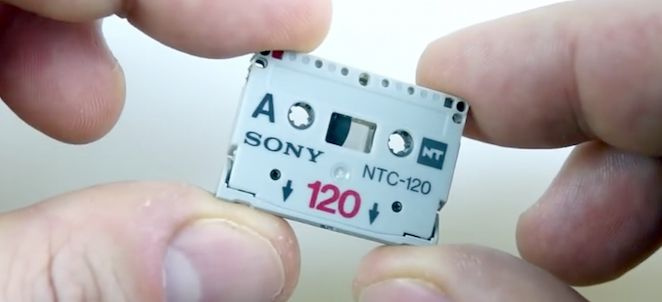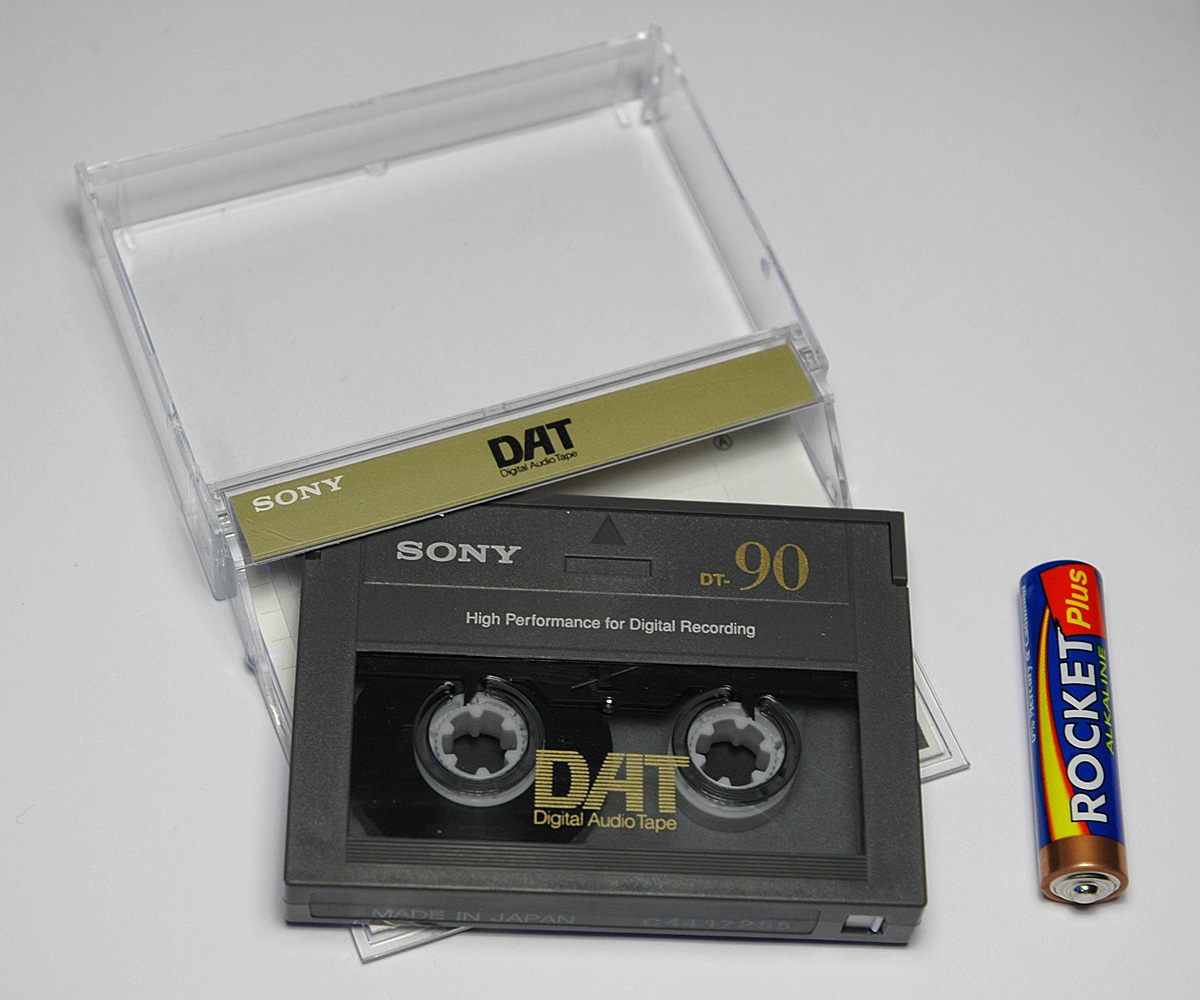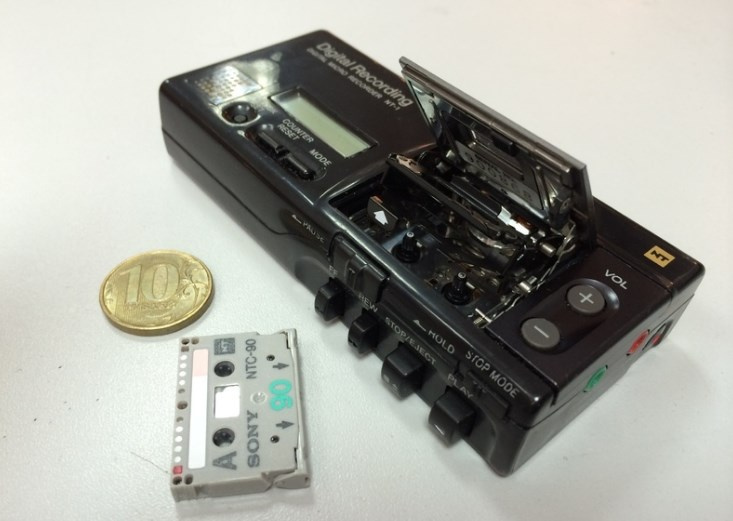DAT: a missed CD killer or another unfairly forgotten format
A year ago, one of the editors of the GT published the most interesting material on the topic of digital cassettes DCC (Digital compact cassette). It then seemed to me that I had previously seen something similar, so in a survey that was published at the end of the post, I boldly clicked on the answer: "I saw." As it turned out later, I was mistaken, in fact, they were completely different carriers, to which, actually, this post is dedicated.

It will be about the format of DAT (Digital audio tape) or R-DAT (Rotary head Digital Audio Tape), which appeared in 1987 and could be a full replacement for both CD and CC (compact cassette), if not a number circumstances. It was DAT that became the first digital cassettes, briefly taking the lead in the competition of professional digital audio recording media. As in the case of DCC, DAT is directly related to the company Philips, which developed the media and reading devices, then in partnership with a future rival, the company SONY.
In fairness it should be noted that SONY and Philips were not pioneers of digital audio recording. The first digital tape recorder was developed in the electroacoustic laboratory of the Japanese broadcasting company NHK in 1967. Coils with a wide (2.54 cm) film were used as a carrier, and reel-type video recorders were used as recorders / players. This miracle of the 60's allowed to get sound with the following characteristics: frequency range: 10 Hz - 15 kHz, sensitivity: 75 dB, SOI + noise: 1%.
The signal was converted with a sampling frequency of 31.5 kHz and 12-bit quantization. The device had incredible characteristics for that time, but it had a lot of flaws, the main ones being: mass (more than 200 kg), just hellish dimensions (approximately, like 2 Soviet radiols) and astronomical cost, which today, taking into account inflation, would be about 900,000 dollars.

Later, in 1979, the company SONY released a prefix to the VHS-VCR, which allows you to listen to digital audio recordings. The mass of the device was 4 kg, the price - $ 1000 (today, taking into account inflation, it is about $ 3300).
In the mid-80s, the developers were well aware of the perspectives of the “numbers” and knew that analog recording was gradually becoming a thing of the past. Trying to get ahead of time, engineers SONY and PHILIPS set themselves the task of creating the perfect (for their time) audio format.

Among the problems that he had to solve were the following:
When developing a new research format, experiments were conducted in two directions, which concerned the mechanism of reading information. The first direction - the use of a static (fixed) magnetic head, seemed more preferable than the use of a moving (rotating) one. Since the rotation of the head suggested a more complex, and therefore less reliable mechanics.

The first tests carried out in 1985 showed that the use of a static head (S-DAT) reduces the surface recording density. As a result, the dimensions of the cassette become larger (86 × 55.5 × 9.5 mm), and the playback time does not exceed 90 minutes, while the R-DAT version was less (73 mm × 54 mm × 10.5 mm) and at the same time allowed to record a full two hours.
Having decided on the rotation of the magnetic head and having solved a number of other fundamental problems, the engineers of the partner companies developed the original tape drive mechanism and in two years prepared a novelty for entering the market. In fact, all the tasks were achieved. After completion of the project, the DAT carrier was a cassette that was 2 times smaller than the standard ACC. In the case of the cassette was placed 3.81 mm magnetic tape with metal powder coating, the thickness of the tape did not exceed 13 microns.

The first prototypes of DAT tape recorders could not boast of compactness. After several months of refinement, a sample appeared that satisfied not only the canons of home and studio audio, but could also be called portable, as there was not much more than a Sony Walkman cassette player. Later came the corresponding model DAT Walkman.

The operation modes of the device allowed
maximum sampling rate of 48 kHz (more than CD). The recording was done without compression using 16 bit PCM.
Realizing that different user groups have different requirements for the carrier and equipment, the creators of DAT have invested several modes of use in the format. For example, a signal could be encoded / decoded at the following sampling rates: 48 / 44.1 / 31 kHz. In addition, as in some analog tape recorders, there were different speed modes.

The most interesting was the “wide track” mode, which was used for high-speed copying studio methods. The width of the track on such a record was 20.41 microns, instead of the standard 13.591 microns. The speed of the tape during this type of recording increased by 1.5 times and was 12.25 mm / s, instead of 8.16 mm / s in other modes.
Cassettes with wide tracks were produced using a special oxide layer (FeO3), which was better suited for the contact method. Due to the higher speed, the limit of the length of the material recorded on one cassette was seriously reduced and was 80 minutes.
After the launch of the first series of DAT tape recorders and cassettes in the market, there was a restrained rush. But, contrary to the assumptions of market researchers, no one perceived DAT as domestic equipment. Many users of that time had not had time to get used to the compact cassettes. Someone used vinyl the old fashioned way, the CD was perceived as the ultimate dream and the standard of perfection. And DAT was also expensive, not only DAT tape recorders, but also the tapes themselves (although the latter were not much cheaper than a CD). Compact cassettes at that time remained the most acceptable option for the masses.

For inexperienced music lovers, the technical advantages of DAT seemed something far away, and overwhelmingly useless. The case was complicated by not a large number of studio tapes with recordings that were available in this format. Things reached the point that blocking the recording mode with frequencies of 44.1 kHz and above (invented to prevent copying licensed CDs) turned out to be a completely useless function. Pirates in principle did not consider DAT as a format for the mass market, and therefore did not need it.
The true benefits of the format are appreciated by studio professionals. The vacuum of the transition from analog tape to mini disc and modern recording methods filled DAT. Professionals liked literally everything in the format, starting with the ability to record a timecode on special service tracks, ending with the possibility of digital lossless recording at 48 kHz.

The latter was simply not available to almost anyone, until the advent of DAT.
Pleased with professionals and comparative noise immunity. To reduce the influence of neighboring tracks used so-called. azimuth recording. Packet and other errors were prevented by multiplication, the use of the double Reed-Solomon code, and the interpolation of uncorrected errors.
Limited use of DAT-cassettes received from the pioneers of digital video. For example, Samsung released an experimental camera with a DAT recorder. Innovation almost did not affect the audiophile community, tired of the film and having a prejudice about any tapes. At that time, phylophonist vectors were oriented either strictly towards the CD or towards archaic vinyl.
One of the original options for the development of the format was the development of SONY called Scoopman NT-1. It was a digital voice recorder that worked with truly tiny cassettes for that time (size 30 × 21.5 × 5 mm, tape width 2.5 mm).

Reducing the size affected the quality of the recording. But, taking into account the creation time of the device, its characteristics were practically unattainable for none of the portable digital voice recorders that existed at the time (if someone else let them in the series).
The recorder implemented: stereo sound, a sampling frequency of 32 kHz (that is, a maximum sound frequency of 16 kHz), a bit width of 12 bits. In 1996, SONY developed the concept of a voice recorder and released an even more advanced model, the Scoopman NT-2.

In other words, they created the killer CD in the mass market, and it turned out the manna from heaven for recording studios and experiments in specific segments.
By 1989, SONY realized that DAT would not reach the mass market and for some time would be the leader of a fairly narrow segment of professional audio. There is a need to shove this format somewhere else. And then DAT became interested in Hewlett-Packard. The fact is that the information capacity of the R-DAT cassette was as much as 1.3 GB (later - 2 GB), while the maximum data transfer rate reached “lightning speeds” of 1.55 Mb / s. Features unprecedented for popular carriers of the time.

For comparison, in 1998 my father bought me a Wiener PC based on a Pentium MMX 233 MHz with a 1GB hard drive - even 9 years after the appearance of DDS, that was quite a lot.
SONY and HP urgently developed new decks and a kind of new DDS format, essentially the same R-DAT, but only as a data carrier. In fact, the first DDS streamers were DAT tape recorders with minor modifications that even inexperienced radio amateurs could make. The DDS format itself is limited to this day, having been developed in the next generations up to the DAT 320 (up to the volumes of 160 and 320 GB, respectively). Previously, the evolutionary forms of DDS were maintained for a long time by Seagate, and to this day, Quantum is supported.

Production of DAT cassettes and decks did not last long. In SONY, it turned off quite quickly, approximately 7 years after the start. The release was quite limited compared to traditional CD players and cassette decks. A number of other companies interested in the format also did not last longer than this period.
The most enduring DAT was in professional audio recordings. In connection with the possibility of recording without loss, a number of studios used DAT cassettes as a matter of principle, instead of more practical mini discs up to the beginning of the 2000s, but even as a format for professionals, it can hardly be called really popular. In addition, DDS (computer DAT) has long been valued as an expensive, but effective carrier, although it also did not receive widespread distribution.
Can you say that the DAT failed? As a replacement for CD and compact cassettes - of course. As one of the first digital audio recording formats - no. History does not know the subjunctive mood, and we will never know what would have happened if R-DAT had replaced the CD. But, the fact is that this “serial” format was one of the best at the dawn of digital sound recording.

It will be about the format of DAT (Digital audio tape) or R-DAT (Rotary head Digital Audio Tape), which appeared in 1987 and could be a full replacement for both CD and CC (compact cassette), if not a number circumstances. It was DAT that became the first digital cassettes, briefly taking the lead in the competition of professional digital audio recording media. As in the case of DCC, DAT is directly related to the company Philips, which developed the media and reading devices, then in partnership with a future rival, the company SONY.
Brief background
In fairness it should be noted that SONY and Philips were not pioneers of digital audio recording. The first digital tape recorder was developed in the electroacoustic laboratory of the Japanese broadcasting company NHK in 1967. Coils with a wide (2.54 cm) film were used as a carrier, and reel-type video recorders were used as recorders / players. This miracle of the 60's allowed to get sound with the following characteristics: frequency range: 10 Hz - 15 kHz, sensitivity: 75 dB, SOI + noise: 1%.
The signal was converted with a sampling frequency of 31.5 kHz and 12-bit quantization. The device had incredible characteristics for that time, but it had a lot of flaws, the main ones being: mass (more than 200 kg), just hellish dimensions (approximately, like 2 Soviet radiols) and astronomical cost, which today, taking into account inflation, would be about 900,000 dollars.

Later, in 1979, the company SONY released a prefix to the VHS-VCR, which allows you to listen to digital audio recordings. The mass of the device was 4 kg, the price - $ 1000 (today, taking into account inflation, it is about $ 3300).
Need for new format
In the mid-80s, the developers were well aware of the perspectives of the “numbers” and knew that analog recording was gradually becoming a thing of the past. Trying to get ahead of time, engineers SONY and PHILIPS set themselves the task of creating the perfect (for their time) audio format.

Among the problems that he had to solve were the following:
- achieve the ability to record without loss of quality of the original signal with 16-bit PCM (pulse-code modulation) without compression;
- provide a sampling rate higher than the CD or the same;
- to achieve the quality of reproduction of records, superior to compact cassettes and equal to the quality of a CD;
- increase device control functionality;
- reduce the size of the carrier and its level of protection from external factors;
- reduce the size of recording / playback devices;
- achieve the ability to record 120 minutes of sound on one medium.
Problem: mobile or static magnetic head
When developing a new research format, experiments were conducted in two directions, which concerned the mechanism of reading information. The first direction - the use of a static (fixed) magnetic head, seemed more preferable than the use of a moving (rotating) one. Since the rotation of the head suggested a more complex, and therefore less reliable mechanics.

The first tests carried out in 1985 showed that the use of a static head (S-DAT) reduces the surface recording density. As a result, the dimensions of the cassette become larger (86 × 55.5 × 9.5 mm), and the playback time does not exceed 90 minutes, while the R-DAT version was less (73 mm × 54 mm × 10.5 mm) and at the same time allowed to record a full two hours.
First successes
Having decided on the rotation of the magnetic head and having solved a number of other fundamental problems, the engineers of the partner companies developed the original tape drive mechanism and in two years prepared a novelty for entering the market. In fact, all the tasks were achieved. After completion of the project, the DAT carrier was a cassette that was 2 times smaller than the standard ACC. In the case of the cassette was placed 3.81 mm magnetic tape with metal powder coating, the thickness of the tape did not exceed 13 microns.

The first prototypes of DAT tape recorders could not boast of compactness. After several months of refinement, a sample appeared that satisfied not only the canons of home and studio audio, but could also be called portable, as there was not much more than a Sony Walkman cassette player. Later came the corresponding model DAT Walkman.
The operation modes of the device allowed
maximum sampling rate of 48 kHz (more than CD). The recording was done without compression using 16 bit PCM.
Modes of operation
Realizing that different user groups have different requirements for the carrier and equipment, the creators of DAT have invested several modes of use in the format. For example, a signal could be encoded / decoded at the following sampling rates: 48 / 44.1 / 31 kHz. In addition, as in some analog tape recorders, there were different speed modes.

The most interesting was the “wide track” mode, which was used for high-speed copying studio methods. The width of the track on such a record was 20.41 microns, instead of the standard 13.591 microns. The speed of the tape during this type of recording increased by 1.5 times and was 12.25 mm / s, instead of 8.16 mm / s in other modes.
Cassettes with wide tracks were produced using a special oxide layer (FeO3), which was better suited for the contact method. Due to the higher speed, the limit of the length of the material recorded on one cassette was seriously reduced and was 80 minutes.
Unwarranted expectations
After the launch of the first series of DAT tape recorders and cassettes in the market, there was a restrained rush. But, contrary to the assumptions of market researchers, no one perceived DAT as domestic equipment. Many users of that time had not had time to get used to the compact cassettes. Someone used vinyl the old fashioned way, the CD was perceived as the ultimate dream and the standard of perfection. And DAT was also expensive, not only DAT tape recorders, but also the tapes themselves (although the latter were not much cheaper than a CD). Compact cassettes at that time remained the most acceptable option for the masses.

For inexperienced music lovers, the technical advantages of DAT seemed something far away, and overwhelmingly useless. The case was complicated by not a large number of studio tapes with recordings that were available in this format. Things reached the point that blocking the recording mode with frequencies of 44.1 kHz and above (invented to prevent copying licensed CDs) turned out to be a completely useless function. Pirates in principle did not consider DAT as a format for the mass market, and therefore did not need it.
Recognition and development
The true benefits of the format are appreciated by studio professionals. The vacuum of the transition from analog tape to mini disc and modern recording methods filled DAT. Professionals liked literally everything in the format, starting with the ability to record a timecode on special service tracks, ending with the possibility of digital lossless recording at 48 kHz.

The latter was simply not available to almost anyone, until the advent of DAT.
Pleased with professionals and comparative noise immunity. To reduce the influence of neighboring tracks used so-called. azimuth recording. Packet and other errors were prevented by multiplication, the use of the double Reed-Solomon code, and the interpolation of uncorrected errors.
Limited use of DAT-cassettes received from the pioneers of digital video. For example, Samsung released an experimental camera with a DAT recorder. Innovation almost did not affect the audiophile community, tired of the film and having a prejudice about any tapes. At that time, phylophonist vectors were oriented either strictly towards the CD or towards archaic vinyl.
One of the original options for the development of the format was the development of SONY called Scoopman NT-1. It was a digital voice recorder that worked with truly tiny cassettes for that time (size 30 × 21.5 × 5 mm, tape width 2.5 mm).

Reducing the size affected the quality of the recording. But, taking into account the creation time of the device, its characteristics were practically unattainable for none of the portable digital voice recorders that existed at the time (if someone else let them in the series).
The recorder implemented: stereo sound, a sampling frequency of 32 kHz (that is, a maximum sound frequency of 16 kHz), a bit width of 12 bits. In 1996, SONY developed the concept of a voice recorder and released an even more advanced model, the Scoopman NT-2.

In other words, they created the killer CD in the mass market, and it turned out the manna from heaven for recording studios and experiments in specific segments.
DAT and computers
By 1989, SONY realized that DAT would not reach the mass market and for some time would be the leader of a fairly narrow segment of professional audio. There is a need to shove this format somewhere else. And then DAT became interested in Hewlett-Packard. The fact is that the information capacity of the R-DAT cassette was as much as 1.3 GB (later - 2 GB), while the maximum data transfer rate reached “lightning speeds” of 1.55 Mb / s. Features unprecedented for popular carriers of the time.

For comparison, in 1998 my father bought me a Wiener PC based on a Pentium MMX 233 MHz with a 1GB hard drive - even 9 years after the appearance of DDS, that was quite a lot.
SONY and HP urgently developed new decks and a kind of new DDS format, essentially the same R-DAT, but only as a data carrier. In fact, the first DDS streamers were DAT tape recorders with minor modifications that even inexperienced radio amateurs could make. The DDS format itself is limited to this day, having been developed in the next generations up to the DAT 320 (up to the volumes of 160 and 320 GB, respectively). Previously, the evolutionary forms of DDS were maintained for a long time by Seagate, and to this day, Quantum is supported.

Total
Production of DAT cassettes and decks did not last long. In SONY, it turned off quite quickly, approximately 7 years after the start. The release was quite limited compared to traditional CD players and cassette decks. A number of other companies interested in the format also did not last longer than this period.
The most enduring DAT was in professional audio recordings. In connection with the possibility of recording without loss, a number of studios used DAT cassettes as a matter of principle, instead of more practical mini discs up to the beginning of the 2000s, but even as a format for professionals, it can hardly be called really popular. In addition, DDS (computer DAT) has long been valued as an expensive, but effective carrier, although it also did not receive widespread distribution.
Can you say that the DAT failed? As a replacement for CD and compact cassettes - of course. As one of the first digital audio recording formats - no. History does not know the subjunctive mood, and we will never know what would have happened if R-DAT had replaced the CD. But, the fact is that this “serial” format was one of the best at the dawn of digital sound recording.
All Articles